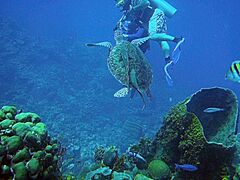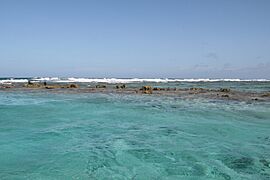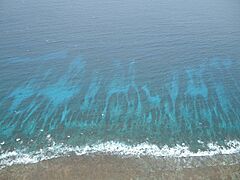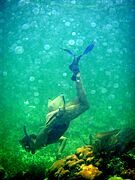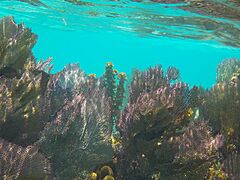Belize Barrier Reef facts for kids

The Belize Barrier Reef is a huge chain of coral reefs. It runs along the coast of Belize, a country in Central America. In the north, it's about 300 meters (980 feet) from shore. In the south, it's about 40 kilometers (25 miles) away.
This reef is a 300-kilometer (186-mile) long part of the Mesoamerican Barrier Reef System. This larger system stretches for 900 kilometers (560 miles). It goes from Cancún in Mexico all the way down to Honduras. This makes it the second largest coral reef system in the world. Only the Great Barrier Reef in Australia is bigger.
The Belize Barrier Reef is a top spot for tourists. Many people come here for scuba diving and snorkeling. It attracts almost half of Belize's visitors each year. The reef is also very important for the country's fishing industry.
In 1842, the famous scientist Charles Darwin called it "the most remarkable reef in the West Indies".
Besides the main barrier reef, Belize also has three special ring-shaped coral reefs called atolls. These are Turneffe Atoll, Glover's Reef, and Lighthouse Reef. Lighthouse Reef is known for the Great Blue Hole. This giant underwater sinkhole became famous in 1970 thanks to Jacques Cousteau. Turneffe Atoll is the closest atoll to Belize City. These different reefs offer many amazing places to dive. You can explore coral walls, tall pinnacles, and flat reef areas.
Contents
Amazing Ocean Life at the Reef
The Belize Barrier Reef is home to a huge variety of plants and animals. Scientists are still discovering new species here!
- 70 types of hard corals
- 36 types of soft corals
- 500 kinds of fish
- Hundreds of different invertebrates (animals without backbones)
Scientists believe they have only found about 10% of all the species living on the reef. This means 90% of the reef's life is still a mystery waiting to be explored!
Protecting the Belize Barrier Reef
Conservation Efforts and Protected Areas
A large part of the reef is protected by the Belize Barrier Reef Reserve System. This system includes seven marine reserves, which are special protected areas in the ocean. It also has 450 cayes (small, low islands made of sand and coral) and the three atolls. In total, this protected area covers about 960 square kilometers (370 square miles).
Some of the protected areas include:
- Glover's Reef Marine Reserve
- Great Blue Hole
- South Water Caye Marine Reserve
- Half Moon Caye Natural Monument
- Hol Chan Marine Reserve
- Important cayes like Ambergris Caye, Caye Caulker, and St. George's Caye.
In 1996, the Belize Barrier Reef Reserve System became a World Heritage Site. This means it's a very special place recognized by UNESCO for its global importance. It was chosen because it's a vital natural home for many different kinds of life, helping to protect them right where they live.
Belize has taken important steps to protect its reef. In 2010, it was the first country to completely ban a fishing method called bottom trawling. This method drags large nets along the seafloor, which can damage corals. In 2015, Belize also stopped oil drilling within 1 kilometer (0.6 miles) of the Barrier Reef.
Threats to the Reef's Health
Even with these protective actions, the reef faces many dangers. These include pollution in the ocean, too much tourism, shipping, and fishing. Natural threats like hurricanes also cause damage.
Global warming is another big problem. It causes ocean temperatures to rise. Warmer water can lead to coral bleaching. This is when corals get stressed and lose their color, often dying. Scientists say that over 40% of Belize's coral reef has been damaged since 1998.
Understanding Coral Bleaching
The Belize Barrier Reef has had major bleaching events. The first big one happened in 1995, killing about 10% of the corals. Another large bleaching event happened in 1998 when Hurricane Mitch hit. After this, biologists saw that almost half of the live coral cover was gone.
When coral bleaching happens, a large part of the coral dies. The rest of the reef tries to heal itself. But it's hard for corals to recover because bleached corals are much weaker. They can easily get sick, and diseases often kill more corals than the bleaching itself. If bleaching keeps happening, the coral reef might not be able to recover at all.
Gallery
-
Green sea turtle with remora fish on its back
-
Snorkeling the reef
See also
 In Spanish: Sistema de Reservas de la Barrera del Arrecife de Belice para niños
In Spanish: Sistema de Reservas de la Barrera del Arrecife de Belice para niños
- List of reefs
- World Heritage Sites in Danger


